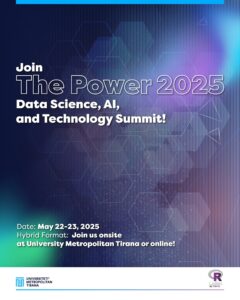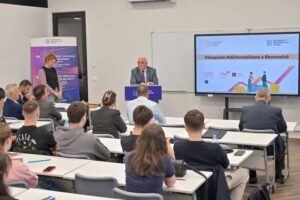PhD proposal Kledia Tirana
PhD director: Prof.Asoc.Dr. Aranit Shkurti
Context and general objectives
The aim of this dissertation is to deploy cost effective security solutions for various businesses using the most cutting-edge techniques based on artificial intelligence and machine learning. The current security solutions for businesses are heavily based on human involvement which makes it economically cost prohibitive especially for medium and small businesses but more importantly inefficient from a security perspective.
We will use both Artificial Intelligence (AI) and Machine Learning (ML) in this work since they are intrinsically linked; AI will indicate to the system what to do while ML will help the system to learn on the job. In the most generic terms, ML will teach a video surveillance algorithm to distinguish between objects that pose a risk and non-threatening objects. While there is a plethora of applications in video surveillance to help protect businesses assets, in this study we will focus on providing cost effective security in a business place especially after hours. We will also indicate how this study can be expanded for other use cases.
The use of AI in the security business is not new and it has been mostly focused on video surveillance. The oldest example of a Video Analytic (VA) application is the detection of abandoned baggage in the airport; this dates back to the 1990s. However, the algorithms used at that time were quite unreliable, often triggering false alarms. The advances in AI and ML have made it possible today to create modern algorithms. A combination of maximizing the use of technology and proper learning and tuning of the algorithms has created the possibility of drastically limiting false alarms.
Scientific program / Methodology / Expected results
The thesis will be organized in six chapters; introduction, literature review for both AI and ML, methodology, solution implementation, results presentation and conclusion.
1)Introduction: will focus on the problem we are aiming to solve which is creating a cost effective and efficient security solution for an after hours business surveillance.
2)The literature review chapter we will look at the AI and ML algorithms.
3)In the methodology chapter we will focus on how to train our algorithm, what should be considered the “normal” or the baseline.
4)In the solution implementation chapter we will explain the practical work including everything in our ecosystem
5)In the results chapter we will present our findings based on the experimentations we will do.
6) Conclusions of the study and its finding.
Some references
Cortes, V., & Jose, C. (2021). Joint Neural Networks for One-shot Object Recognition and Detection.
Faulkner, H. (2021). General and Fine-Grained Video Understanding using Machine Learning & Standardised Neural Network Architectures.
Jiang, L., Chen, J., Todo, H., Tang, Z., Liu, S., & Li, Y. (2021). Application of a Fast RCNN Based on Upper and Lower Layers in Face Recognition (Vol. 2021).
Kumari Sirivarshitha, A., Sravani, K., Priya, K., & Bhavani, V. (2023). An approach for Face Detection and Face Recognition using OpenCV and Face Recognition Libraries in Python. 2023 9th International Conference on Advanced Computing and Communication Systems, ICACCS 2023.
Luca, A.-V., Simon-Várhelyi, M., Mihály, N.-B., & Cristea, V.-M. (2023). Fault type diagnosis of the wwtp dissolved oxygen sensor based on fisher discriminant analysis and assessment of associated environmental and economic impact (Vol. 13). MDPI.
Omer, F. M. (2024). Application of Principal Component Analysis to Vehicle Sales: Case Study at IBM Company. . Journal of Humanity Sciences. .
Osowski, S., & Siwek, K. (2020). CNN application in face recognition (Vol. 96).
Peng, P., Portugal, I., Alencar, P., & Cowan, D. (2021). A face recognition software framework based on principal component analysis. PLoS ONE, 16(7 July).
Pham, M., Courtrai, L., Friguet, C., Lefèvre, S., & Baussard, A. (2020). YOLO-fine: One-stage detector of small objects under various backgrounds in remote sensing images (Vol. 12).
Rajeshkumar, G., Braveen, M., Venkatesh, R., Josephin Shermila, P., Ganesh Prabu, B., Veerasamy, B., . . . Jeyam, A. (2023). Smart office automation via faster R-CNN based face recognition and internet of things (Vol. 27).
Rajeshkumar, G., Braveen, M., Venkatesh, R., Shermila, P., Prabu, B., Veerasamy, B., . . . Jeyam, A. (2023). Smart office automation via faster R-CNN based face recognition and internet of things (Vol. 27). Elsevier.
Redmon, J., Divvala, S., Girshick, R., & Farhadi, A. (2016). You only look once: Unified, real-time object detection.
Sun, F. (2023). Face Recognition Analysis Based on the YOLO Algorithm (Vol. 2).
Zhang, H., & Cloutier, R. (2022). Review on One-Stage Object Detection Based on Deep Learning (Vol. 7).
Živanović, S., Abramović, N., Živanović, M., & Smolović, S. (2023, 4). INNOVATION MANAGEMENT ON THE WAY TO BUSINESS EXCELLENCE (Vol. 17).




